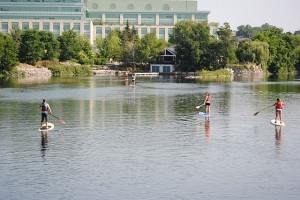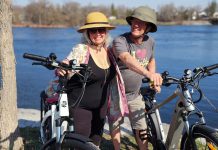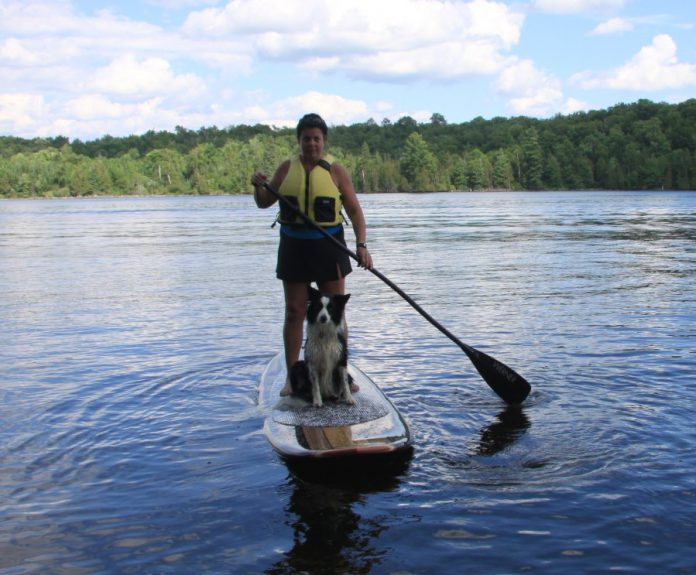I’m a water girl.
That’s why I’ve never strayed far from my home in the “Land of Shining Waters” known as The Kawarthas. Since receiving a canoe for my Grade 8 graduation, I’ve been paddling all of my adult life. I started kayaking in 1994 and have a small collection of kayaks at the cottage.
So when something new on the water comes onto the scene, I’m keen and curious to find out more about it.
During 2011, I learned of Wild Rock Outfitters’ demos for “Stand Up Paddle” (“SUP” for short) at Peterborough’s Millennium Park, just below the Silver Bean Café.
I put SUP on my want-to-learn list and this past June booked myself into two classes, led by Wild Rock staffer Jonathan Moreno.
I have since obtained my own board and gear and, as a six-week practised “newbie”, I feel qualified to pass on some novice dos and don’ts for this great water sport. Yes, I’m hooked on SUP. And no, I have not fallen off or taken on any serious bruises — yet.
As part of my learning process, I spent time watching videos on SUP paddling tips and I recommend this tutorial process for beginners. In this article, I’m including some videos that I found helpful.
Getting started
First, some basic beginner observations:
- Yes, practising yoga helps. Good balance is required for SUP. When I paddle our lakeshore, “do you need good balance?” is definitely the most frequently asked question I get from onlookers.
- Yes, it’s a great core workout.
- Focus is required, but if you over-think what you are doing you’ll probably lose balance — or at least your grace and maybe some pride. Just get comfortable with your board of choice, a forward stroke, a solid turn technique, and keeping your eyes straight ahead on the horizon — and move on from there. It’s a sport with a bit of learning time, followed by a lifetime of practice.
Choosing a board
There are many shapes, sizes, types and uses for SUP boards, ranging from flatwater only to white water. A combo board for both surf and flatwater would be somewhere in the middle range.
At the Wild Rock demos, I tried four boards that all felt vastly different. The first board was longer, leaner and faster than the others (I still lust for this board); the second was the same width, but stable and wider; the third definitely had more rocker (roundness on the underside) and was meant for some surfing use; and the fourth was a beginner board (“Big Easy”).
All these boards are available for rent at Wild Rock, but I recommend getting to a demo session if you can. Jonathan will help you to feel comfortable with a forward stroke and the demo will allow you to try different boards and paddles.
As with kayaks, all boards feel different and the fit can be a very personal comfort level and choice. Of the four boards I tried, I felt good on two and a little uneasy on the other two. Of the two I liked, one was much more stable with three fins. The other was sleeker and faster, but only had a single fin and therefore less tracking.
I ended up buying the more stable board, but I know I’ll be upgrading to “sleek and sporty” at some point in the future (I’ll keep the stable board for cottage visitors who want to try SUP).
Equipment
A whistle, PFD, paddle, and board are required equipment with you at all times on the water. If you plan to SUP-surf, it’s recommended to have an ankle leash on board and tethered.
Some boards also come with extra accessories like a deck pad, some do not. If you buy a board, you may get lucky (as I did) and get a full package: the board, deck pad, great paddle, an ankle leash and a carry case.
Your paddle will be much longer than any you have ever seen, and should be fitted to your height. Some are made with length-adjustable sections.
Starting out

At this point in the demo, I was very grateful to be familiar with a yoga stance. Try to get used to moving your feet around. If they stay planted to the board like glue, your movements may be too rigid. Admittedly, it was my second time out before I got comfortable moving my feet at all and leaning the board from side to side.
Getting Started
Forward stroke and turns
If you can get comfortable paddling forward and turning, you’ll be ready to practise! A general rule is that keeping your paddle in the water gives you more stability. Moving forward also provides stability — so if you hit boat wake or wind, you can keep moving — and the stronger your stroke is, the better. Your stance is shoulder-width apart and knees flexible.
You want to be holding your paddle straight up vertically and aim for a long vertical stroke. Your goal is a nice, long solid sweep from the front of board to the back, with a strong oblique crunch to the side. After you do that into the wind for 30 minutes, you’ll agree with me about the workout factor (remember, I did say practice is required!).
Ideal Forward Stroke
Stand Up Paddling – Sweep Strokes for turning and corrections
4 Golden Rules of SUP
Beginner balance tips
You can view a full series of instruction videos and board tips at StandUpPaddlingTV’s YouTube channel.
Control Strokes
Once you get comfortable on the board and have a solid forward stroke, the inevitable next question is how to paddle in a straight line — also known as tracking.
Jonathan was quick to point out during the demo that the classic canoe “J” stroke is useless on a SUP board. However, what he referred to as a “C” stroke — the reverse of a J stroke — can be useful. The “C” occurs at the front of the board as a small scoop in. When done properly, the board moves forward, shifts slightly to one direction, and then corrects itself back into straight tracking.
I have yet to find any extensive documentation of the C stroke online, but I can tell you I managed to get it to work — but I’m still practising. Wind and waves play a big role in tracking and you need to judge the conditions. Sometimes three or four forward strokes, and then a switch to the other side, is the way to go in a stiff wind.
One method I am relying on more readily is leaning my weight to one side, as one would when paddling a canoe solo with a J stroke. I bend one knee slightly and keep the other leg straighter on the paddle side, which works well for me.
As you head out to try SUP, be sure to get some professional advice, be prepared with all necessary equipment, and stay safe on the water!
For Future Advanced Fun
Advanced Turn: Cross Bow Turn
Fitness on your board



























